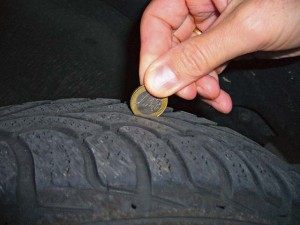The snow has already started to fall in the KMC, and Dr. Bettina Hierath from the German Automobile Club (ADAC) said motorists should already have their winter tires mounted on their vehicles, and the consequences of not having them on in an accident can be severe.
“If you are involved in an accident and you are driving with the wrong tires, you will have to pay,” she said. Fines can be as high as €80 if caught driving with summer tires.

In the case of an accident with summer tires, the insurance company may have the right to refuse payment.
Snow tires are specifically indicated “M+S,” mud and snow. They have the necessary grip for slippery roads. The small zigzag slits in the tread block of the tire allow better contact with the road surface. This reduces braking distances significantly.
“Summer tires on slippery roads can be a real threat to your life and that of others,” Hierath said.
Here are simple tips from the ADAC for changing and storing tires safely.
First, check your winter tires. Are they still good? In the U.S. and many European countries, a minimum tread depth of 1,6 mm (of 2/32 of an inch) is required by law. However, according to information published by the National Center for Biotechnology Information (NCBI), research suggests even on minimally wet roadways, “tires with less than 4/32 of an inch tread depth may lose approximately 50 percent of available friction in those circumstances, even before hydroplaning occurs.”
Coming to the same conclusion, the ADAC recommends a minimum of 4 mm for greater safety. You can check the depth yourself by sticking a euro coin into the tread (see photo). If the golden edge remains visible, your tire is worn down.
If your tires are more than 10 years old or are flawed with visible damage, you may require a new set.
It is also a good idea to mark your summer tires. To make fitting in spring easier, write a “FL” for “Front Left” or “RR” for “Rear Right” on the tires. This is important because you must never exchange your tires cater-cornered, whereas using rear for front and vice versa is even recommended for a more even abrasion. Don’t forget to add 0,5 bar to the summer tires, because they lose pressure during storage time, which can cause damage.
Do you have tires on wheel rims? If so, they need to be stacked or put separately on hanging hooks on the wall. Tires without rims need to be kept vertically on a dry clean space underground in a cool, dark place. “You should do a quarter turn every couple of weeks,” Hierath said.
If you don’t want to change your tires yourself, get an appointment at a garage as soon as possible. You can also have them stored there.
According to a survey made by www.auto.de, prices for changing tires ranges from €65 to €100 in Rheinland-Pfalz. Storage will cost between €118 and €120.
The ADAC has created a form to make sure the garage finds your tires again in spring, also preventing loss or mix-ups. The form includes all details of your property, such as the producer, model type or size. The form is downloadable at www.adac.de.
“This is all a matter of little time and effort,” Hierath said. “Filling out a form, changing your tires and properly storing away your summer ones, that’s really not a big deal, but it can spare much hassle and save many euros.”







